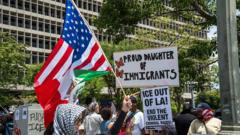As President Donald Trump's administration intensifies its crackdown on undocumented immigrants, businesses critical to the US economy are raising alarms about the depletion of their workforces. In Maryland, Victor Moran, the CEO of a sizable cleaning company, has experienced a notable drop in his employee count, losing around 15 staff members as temporary protections for Venezuelan and Nicaraguan immigrants are rescinded. The ripple effect of Trump's policies threatens to cost him hundreds more workers, complicating hiring processes in a climate that has increasingly relied on immigrant labor.
Statistics underline the urgency of this issue; last year, nearly 20% of the American workforce consisted of immigrants, a number that has soared from less than 10% in 1994. While Trump aims to address illegal immigration—which constitutes about 4% of the workforce—his administration's actions, including ramping up workplace raids, have sparked widespread concern within the business community. This resumption of aggressive deportation tactics aims not only at those without documentation but also places intensifying scrutiny on individuals with student and temporary work visas.
For many immigrants like Justino Gomez, who utilizes Temporary Protected Status (TPS), these measures sow deep anxiety. Gomez has spent three decades in the US as a worker in various capacities including restaurant roles and now as a cleaner, contributing significantly to the education of his daughter abroad. He expressed the burdensome stress of daily life, fearing deportation as a consequence of government crackdown strategies.
The economic ramifications of such policies could be substantial, with experts warning of slower workforce growth and the potential for inflation as businesses face challenges in hiring and retention. Giovanni Peri, an economist, cautions that the US could mirror Japan's economic stagnation if it continues to restrict immigration while facing an aging population. With services and industries reliant on immigrants already noting a challenging labor market, companies are voicing concerns about their ability to maintain operations without a sufficient workforce.
As various sectors struggle to adapt to these changes, industries like caregiving and agriculture, which often lean on immigrant labor, report difficulties in recruitment and retention of employees. Adam Lampert, leader of a caregiving company, noted the critical role that immigrants play within his workforce, and projected that Trump’s deportation policies could lead to significant inflation as market demands shift.
Federal responses to this labor shortage have been mixed. While some industries advocate for legislative reforms, including a new visa program for construction workers as highlighted by the National Association of Homebuilders, the focus remains heavily entrenched in enforcement rather than solutions. In Texas, the CEO of a major hospital network echoed similar sentiments, indicating the long-term gap that would result from significant limitations on immigrant labor, particularly as the need for healthcare services grows.
In contrast with earlier promises of policy reform, the Trump administration appears committed to intensifying immigration enforcement policies, leaving a cloud of uncertainty over the labor market and the overall economic landscape. As the next steps unfold, industrial leaders and immigrant communities alike brace for potential disruptions that could alter their livelihoods.




















